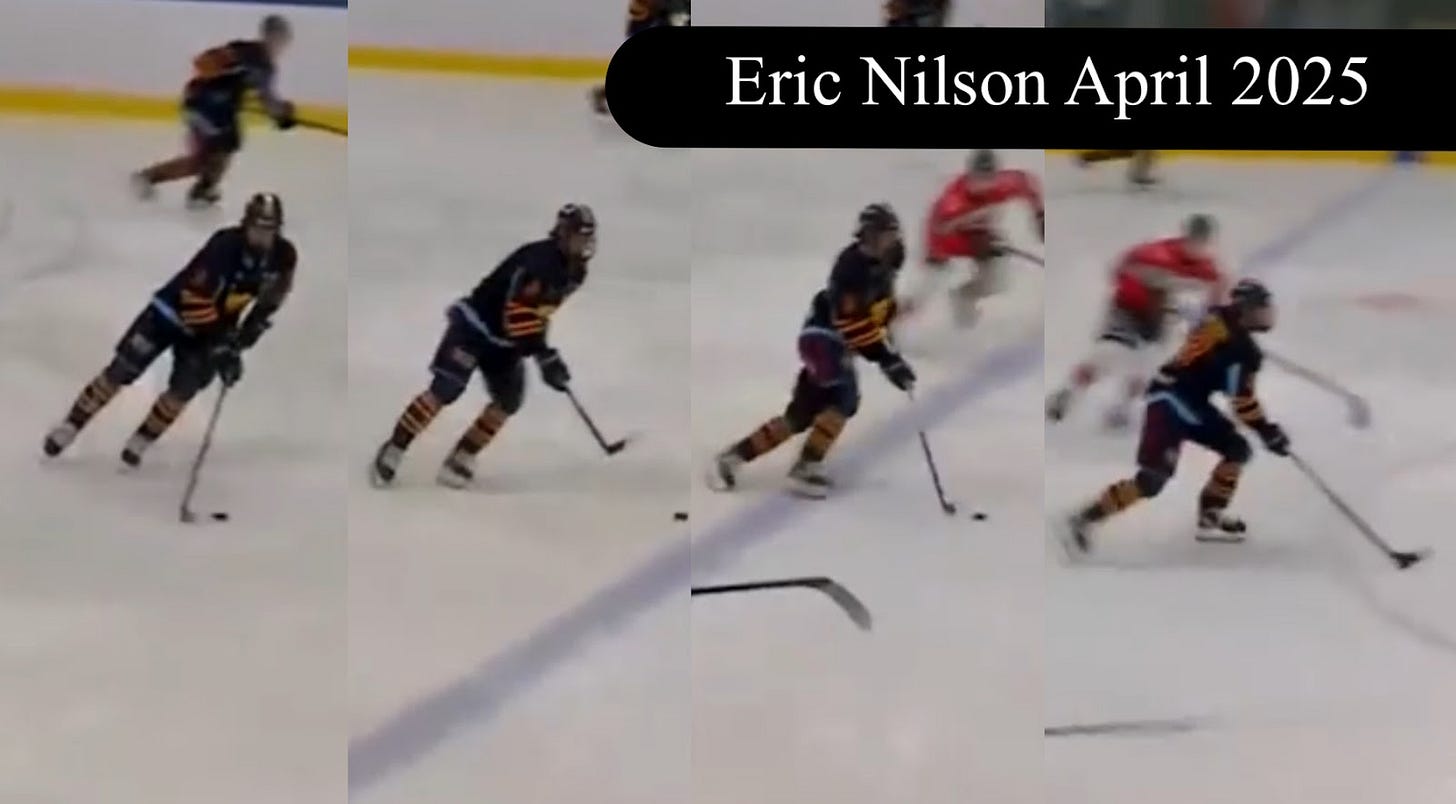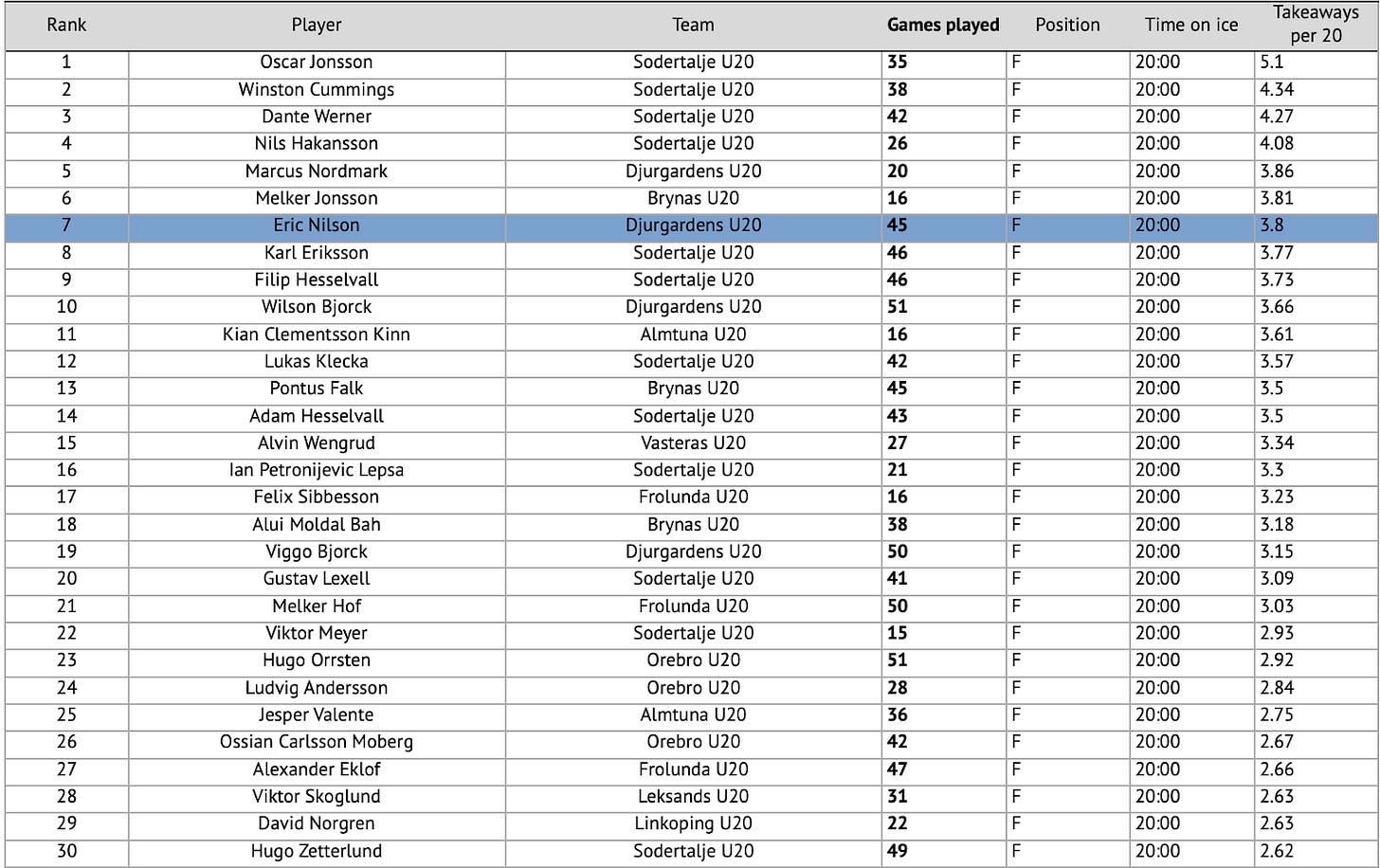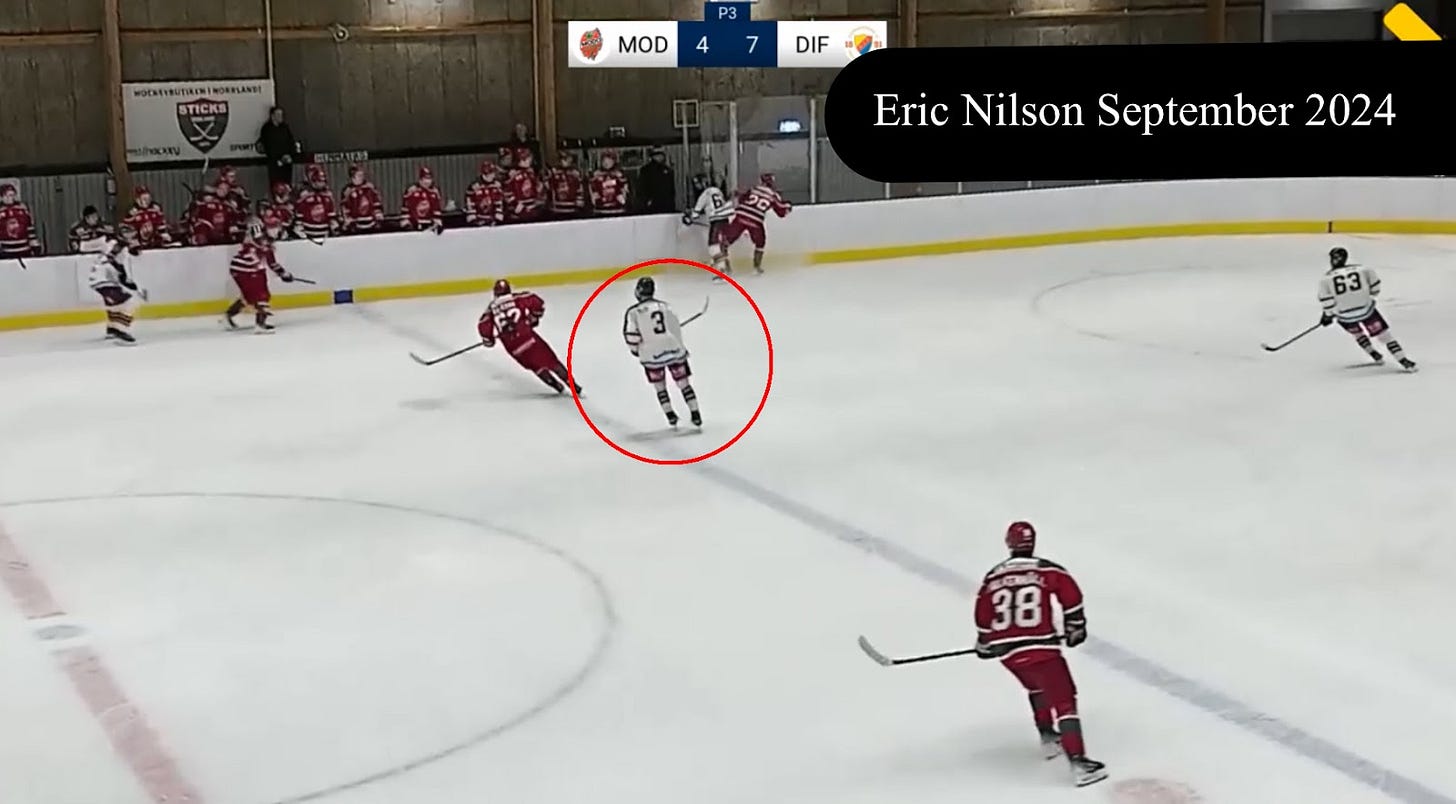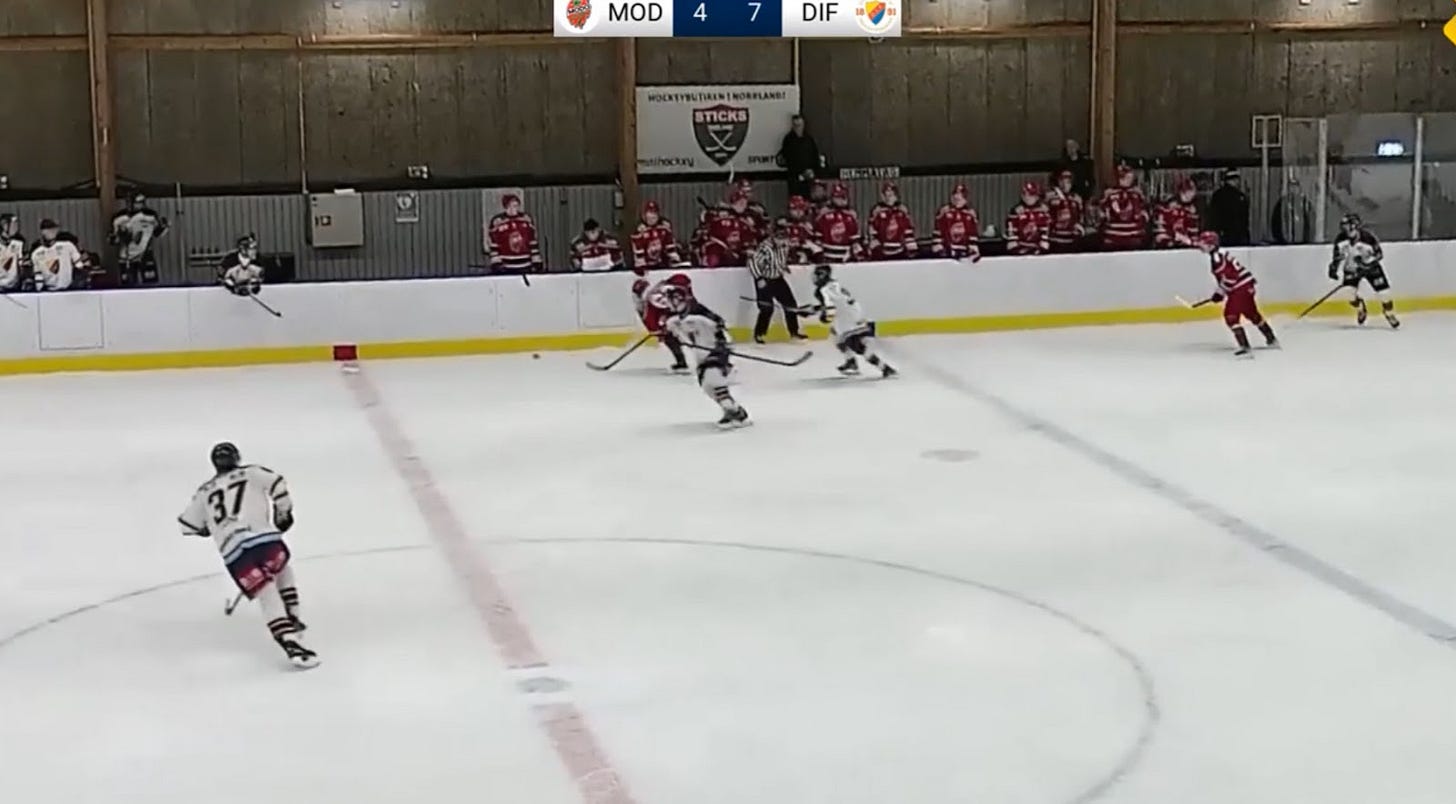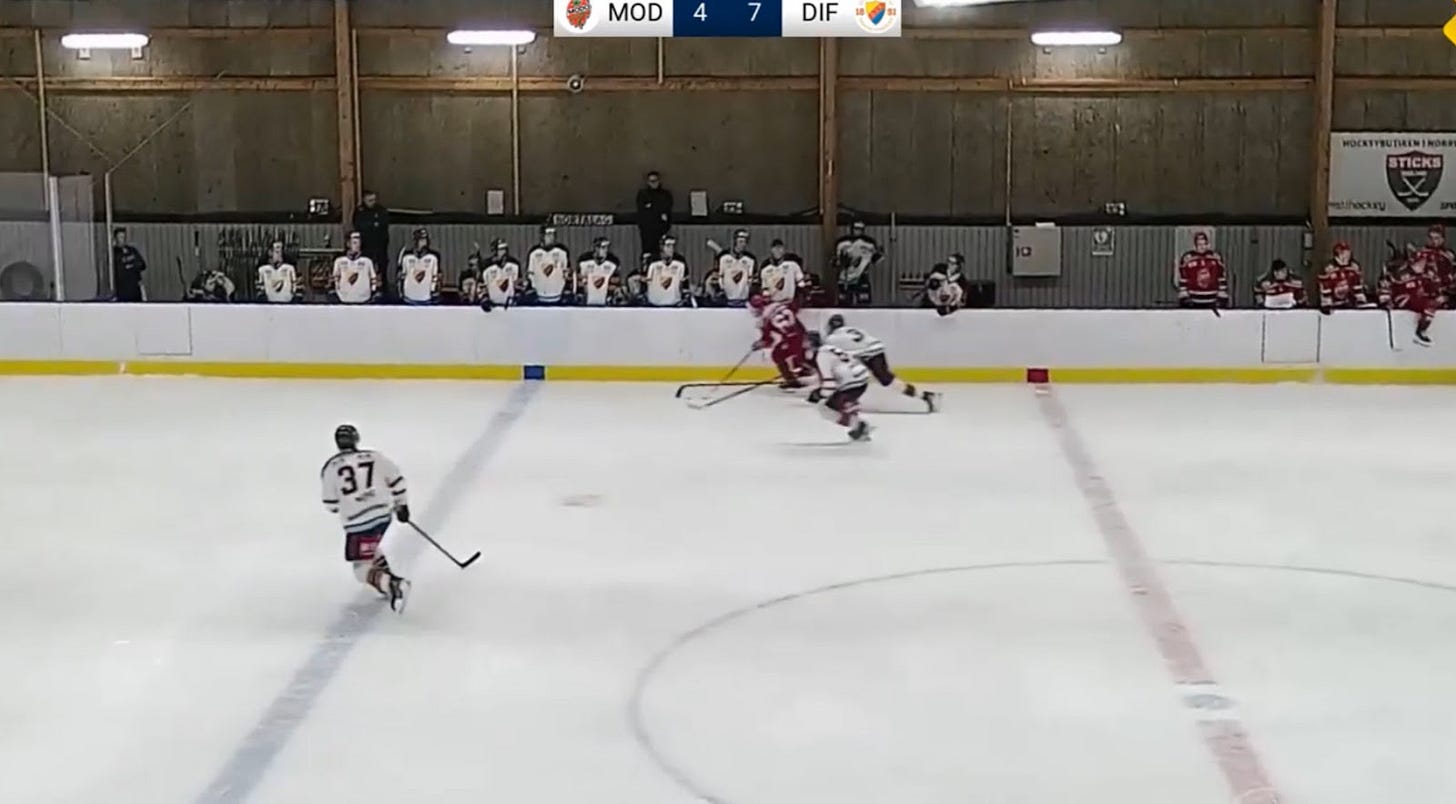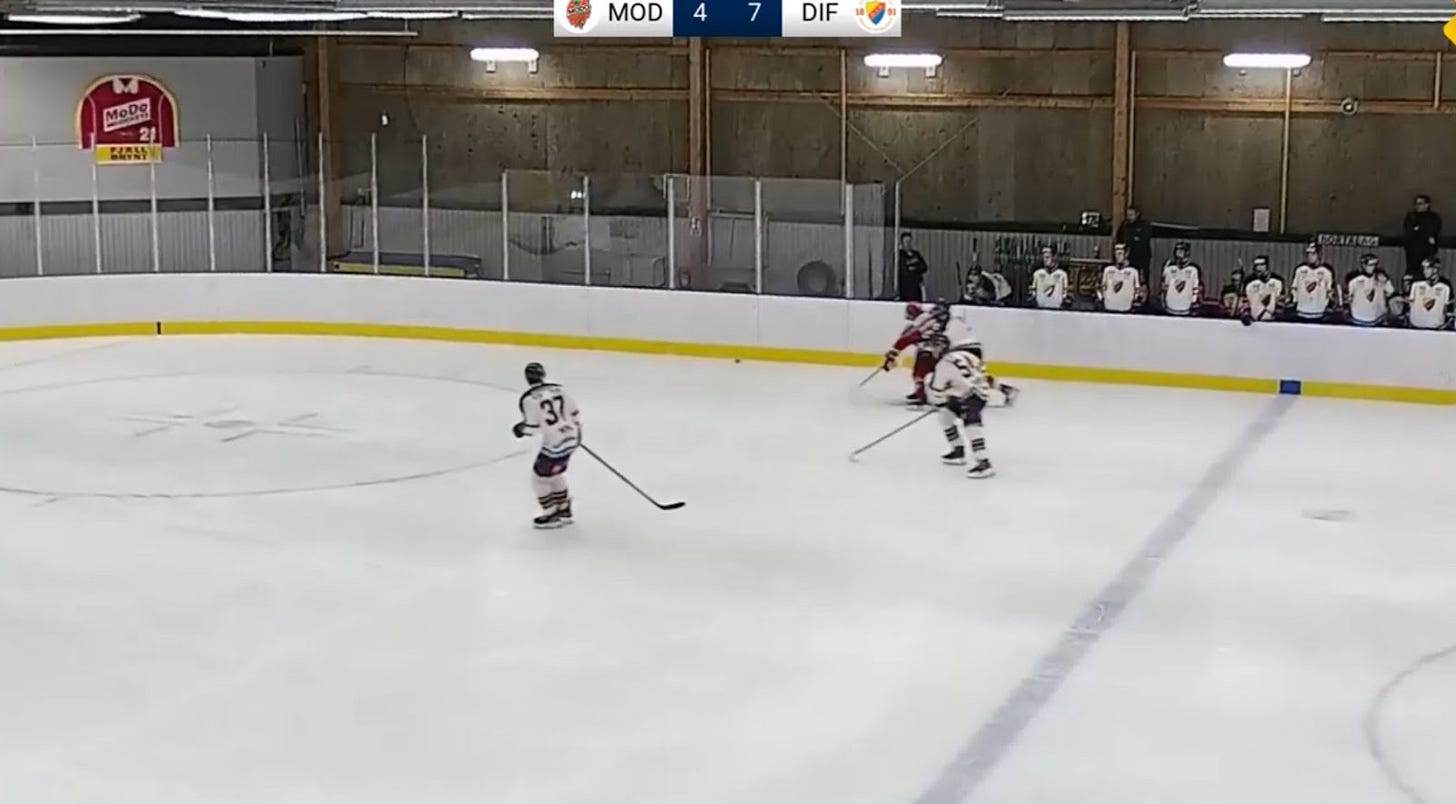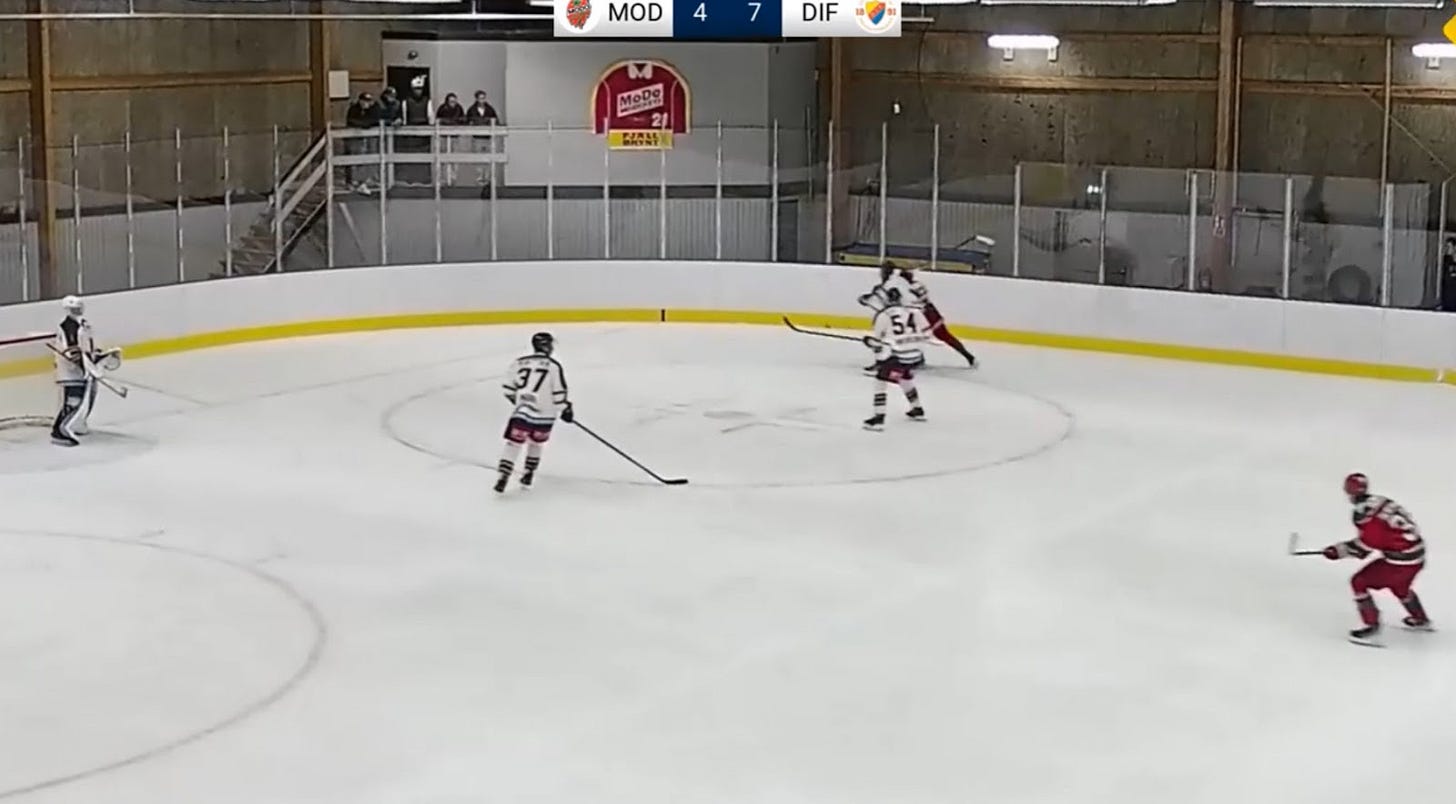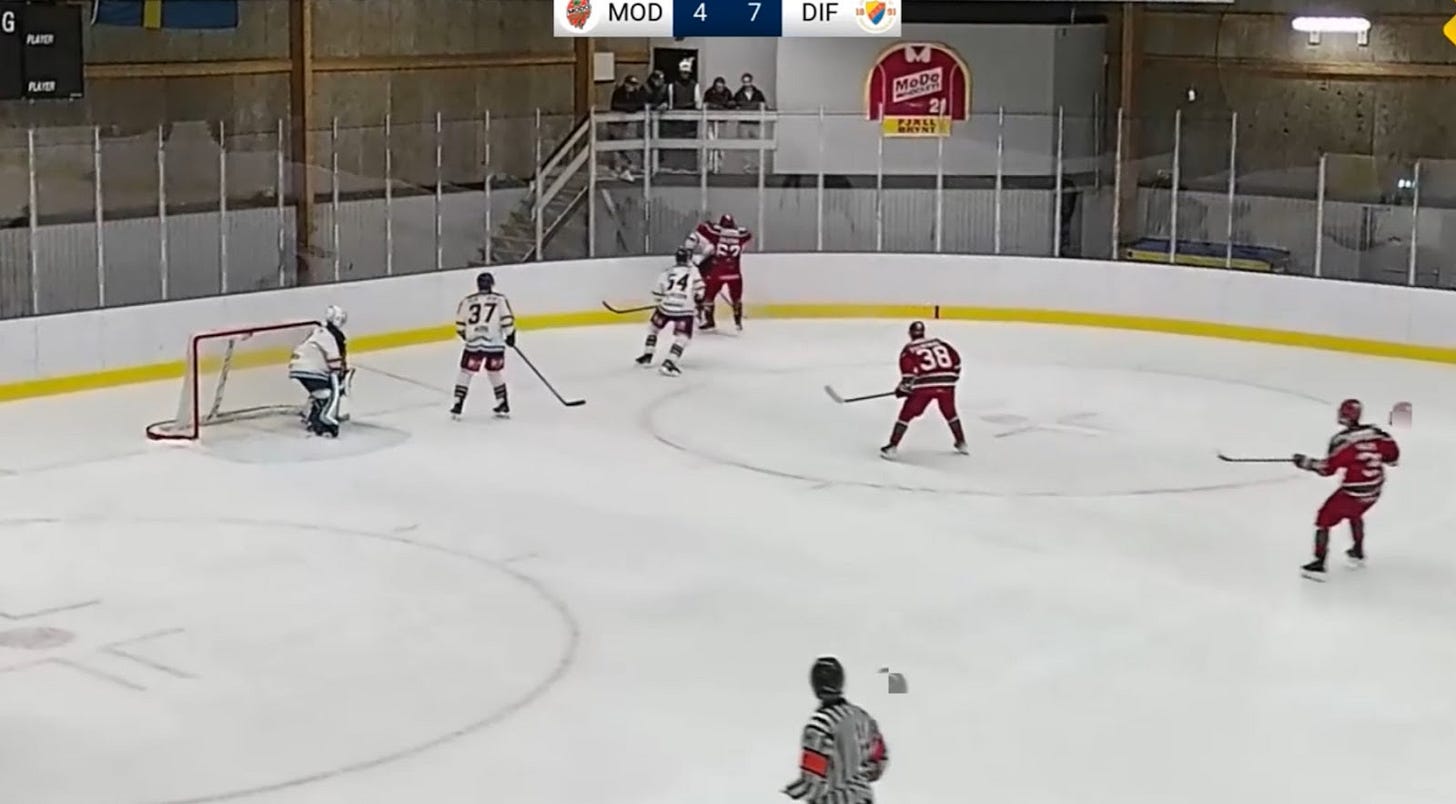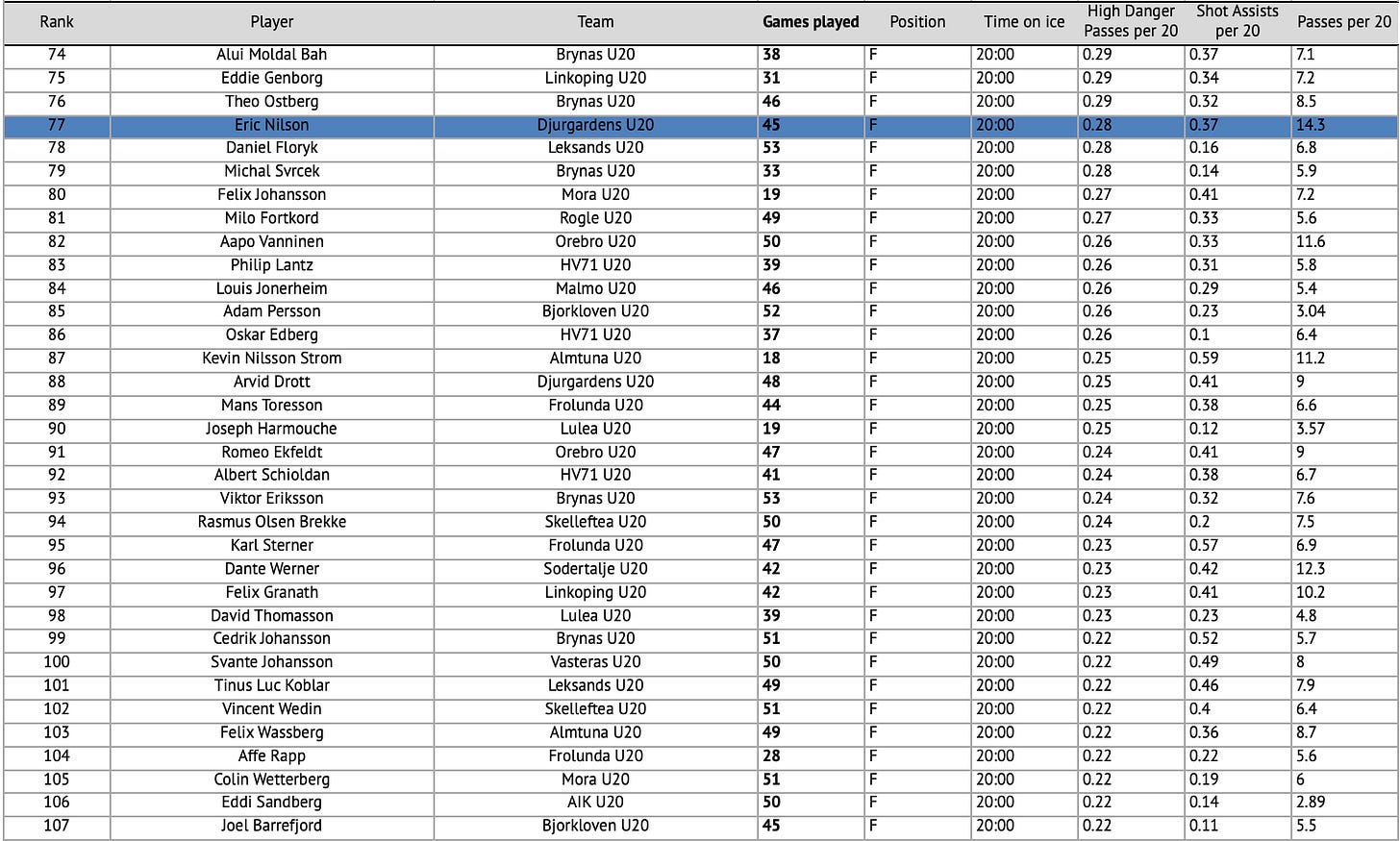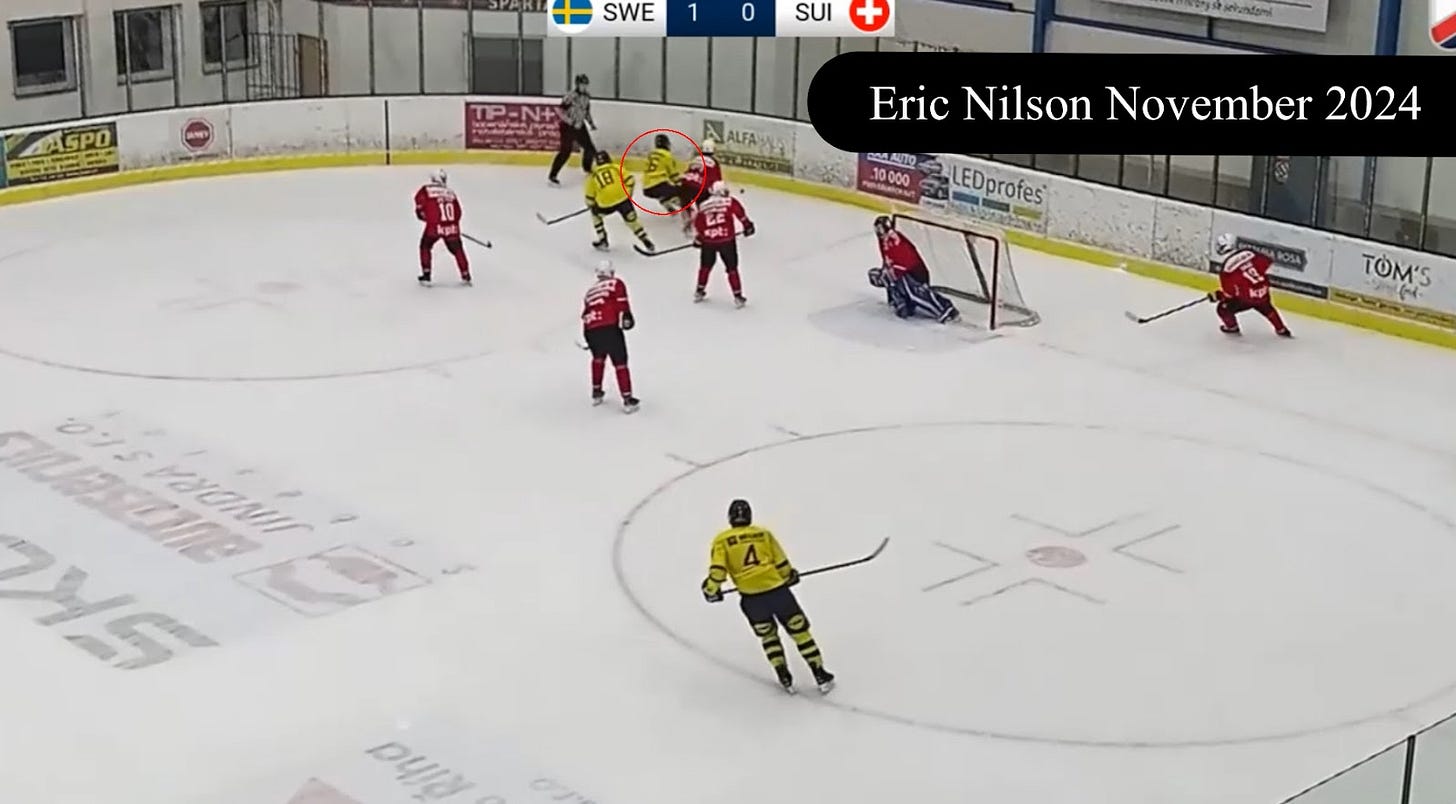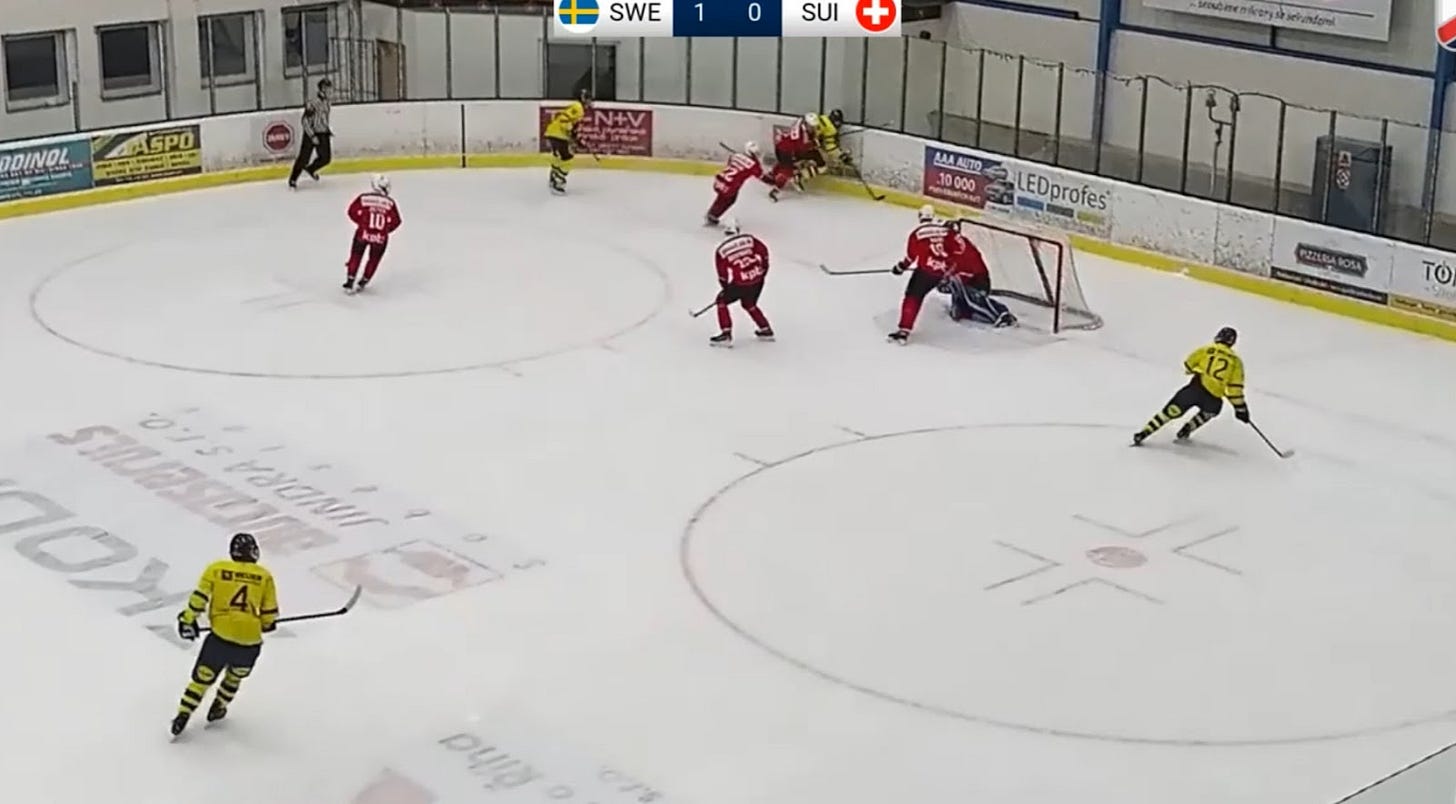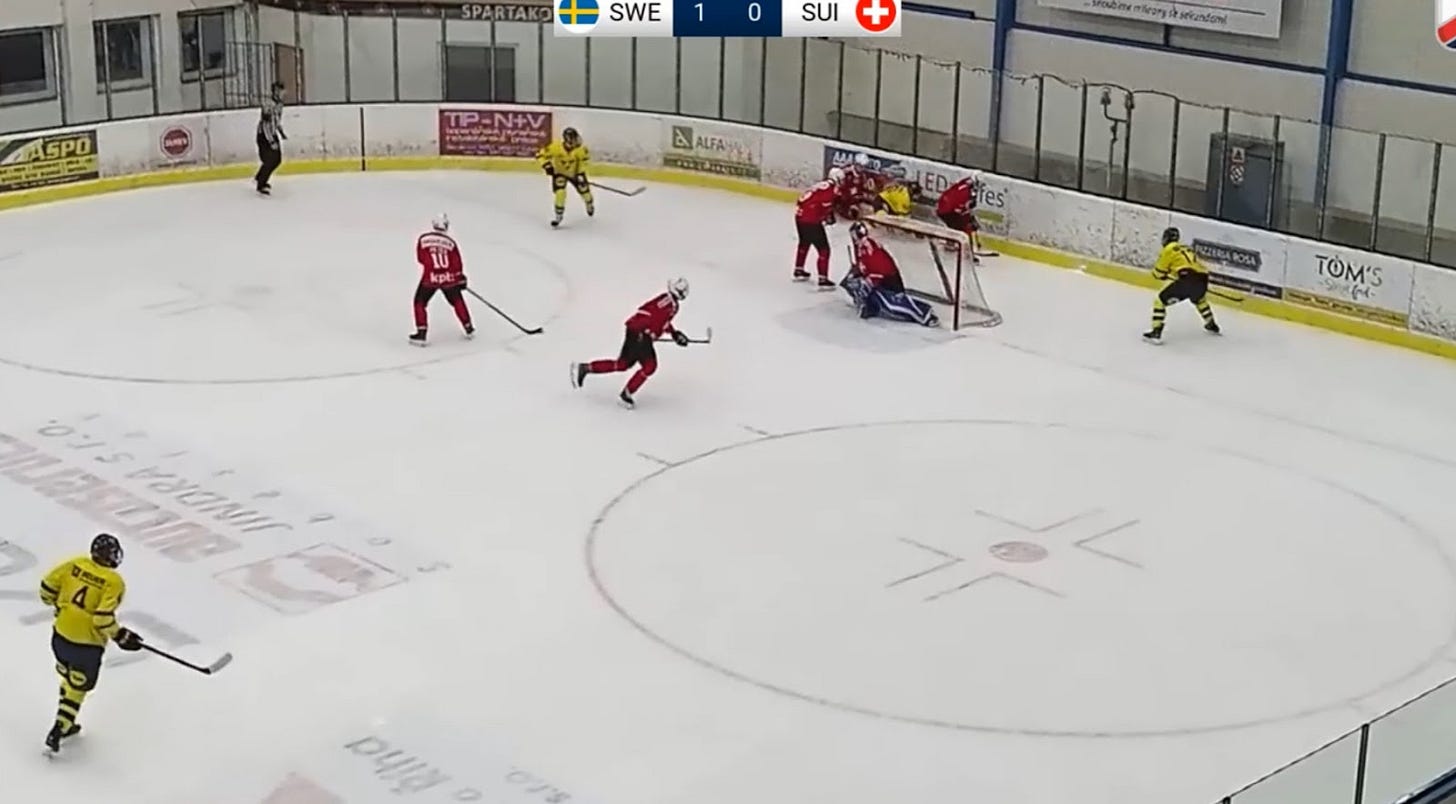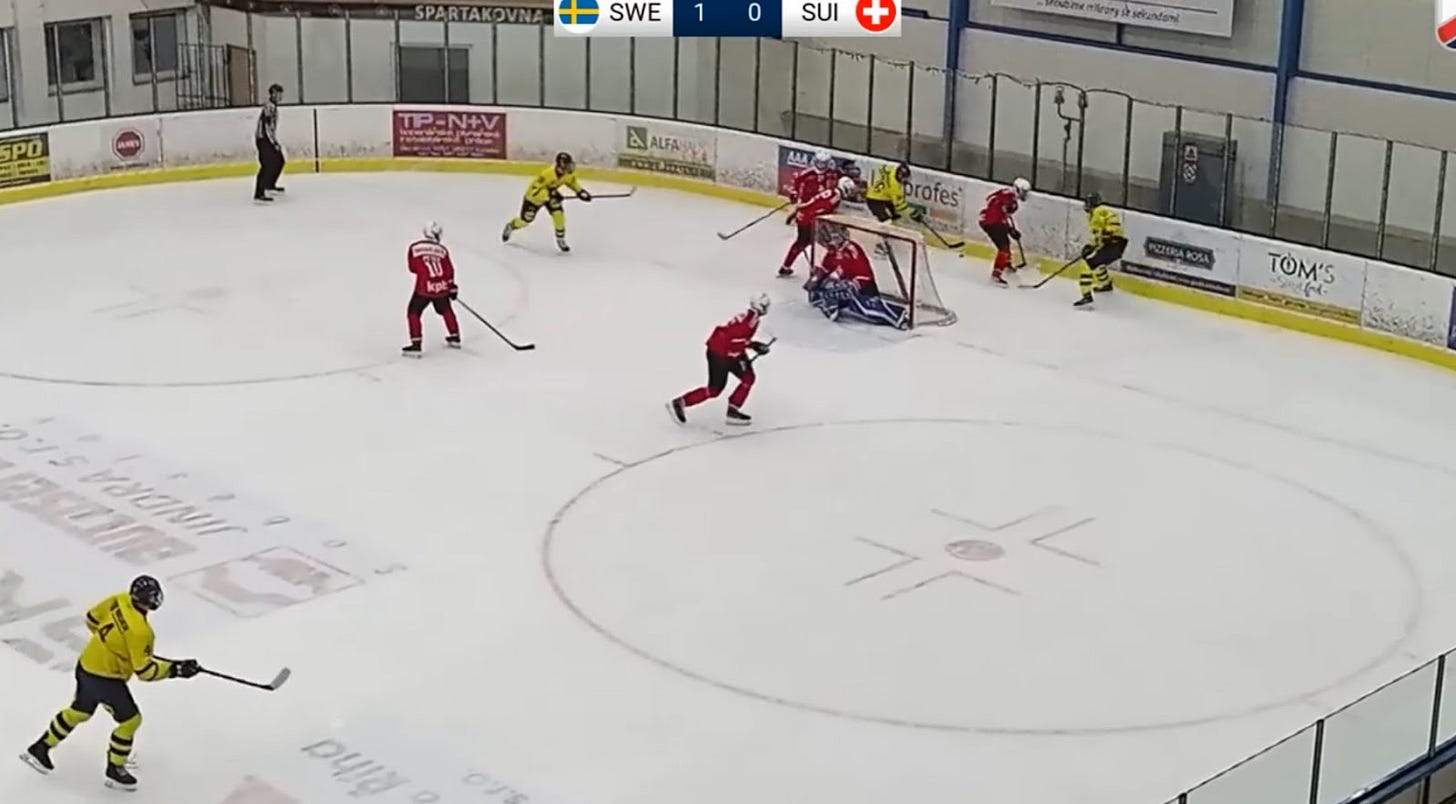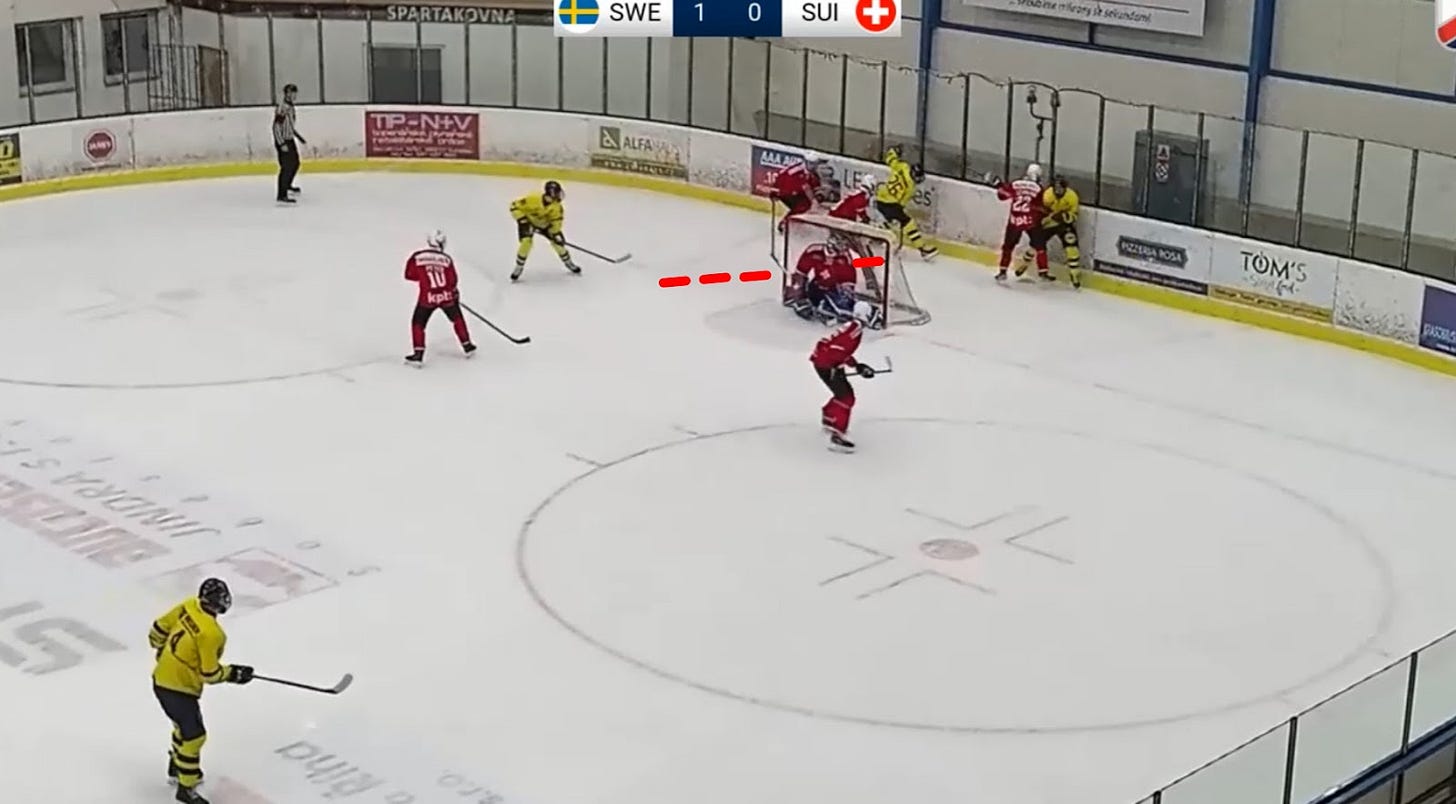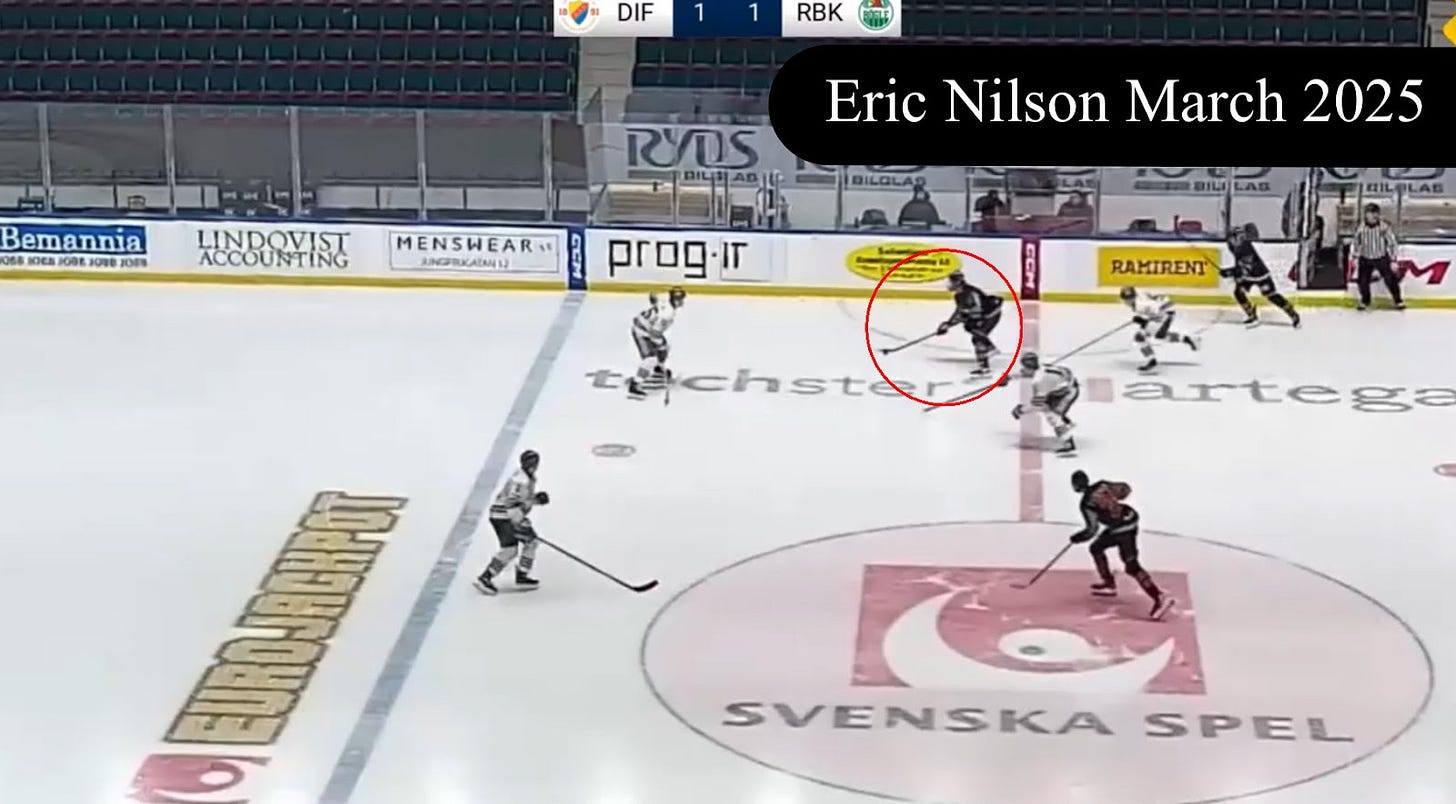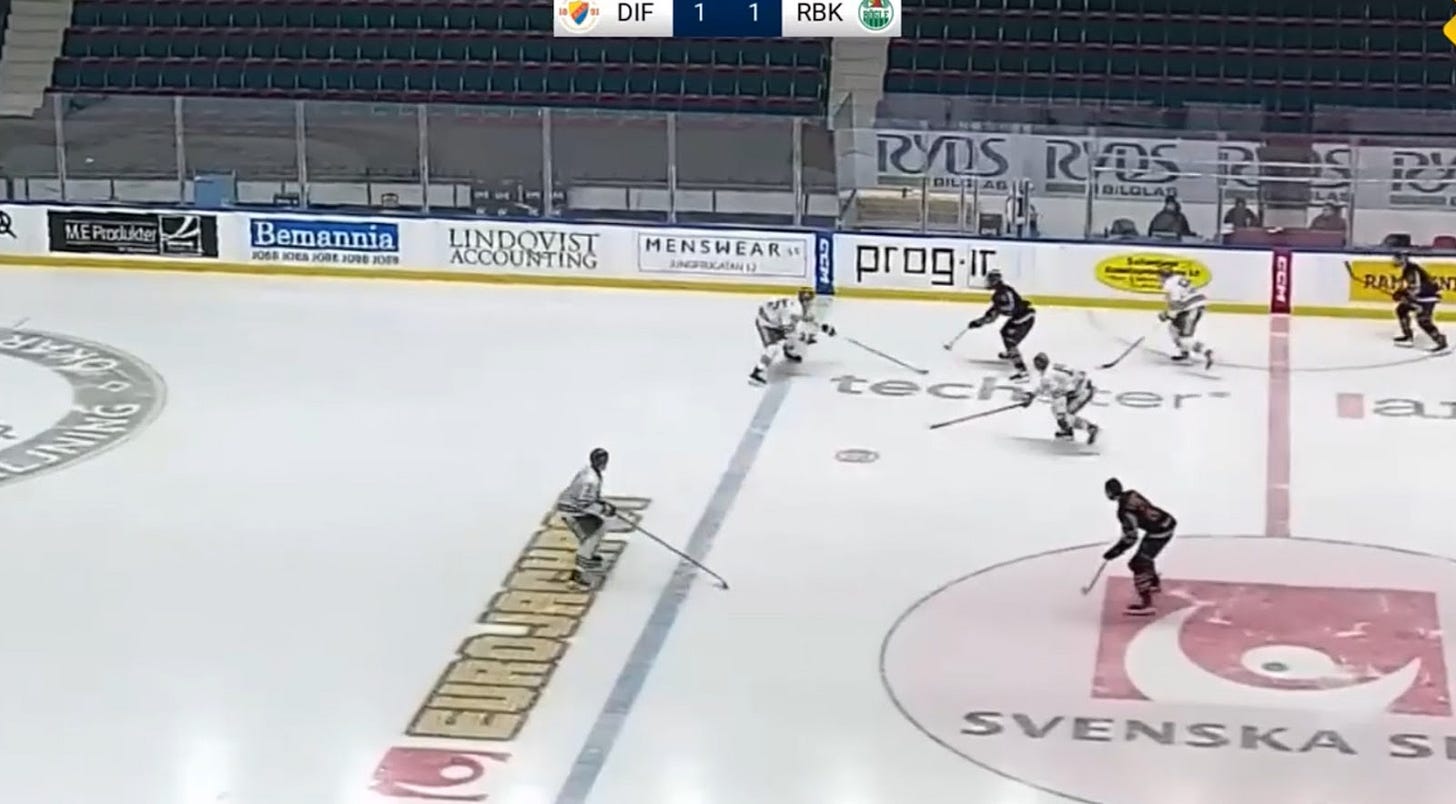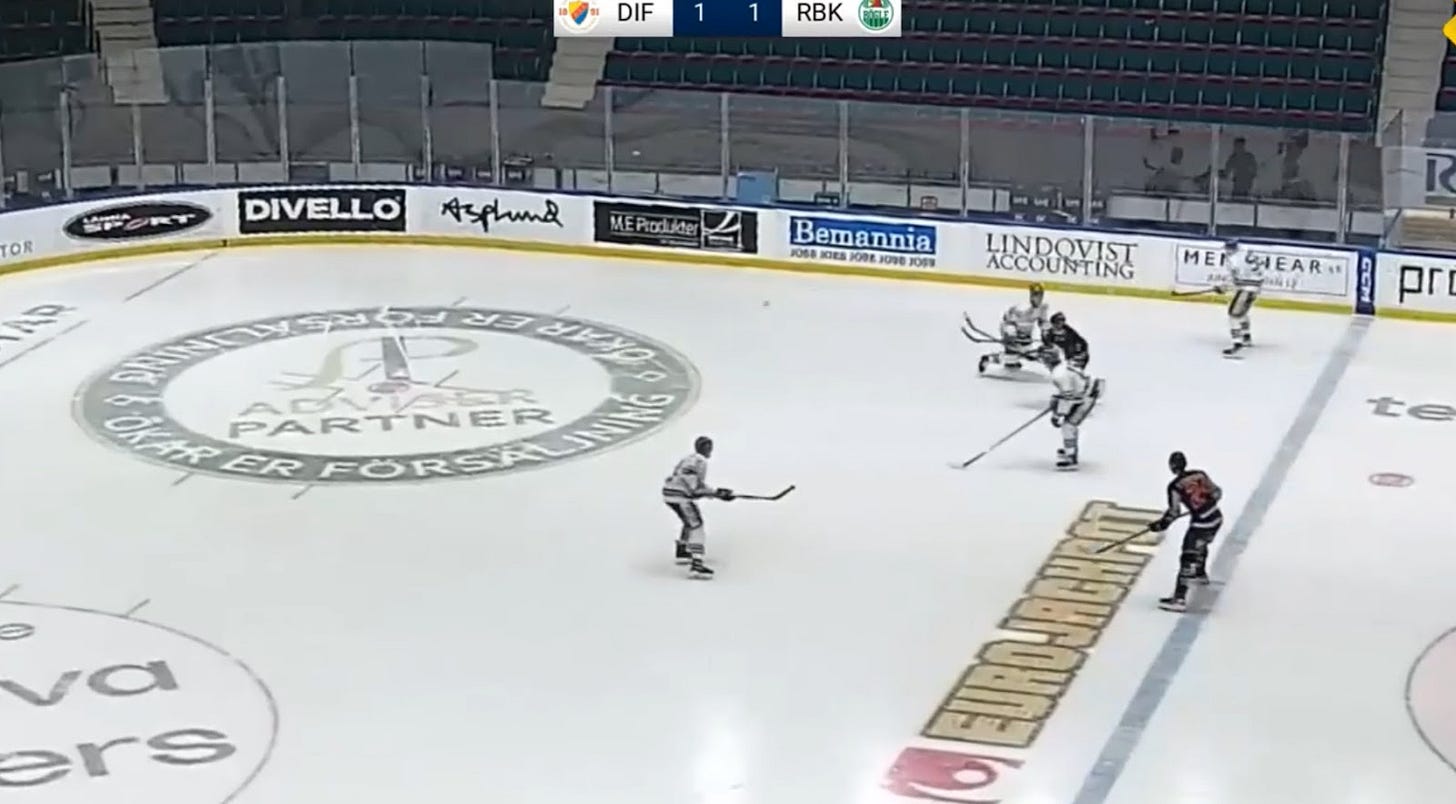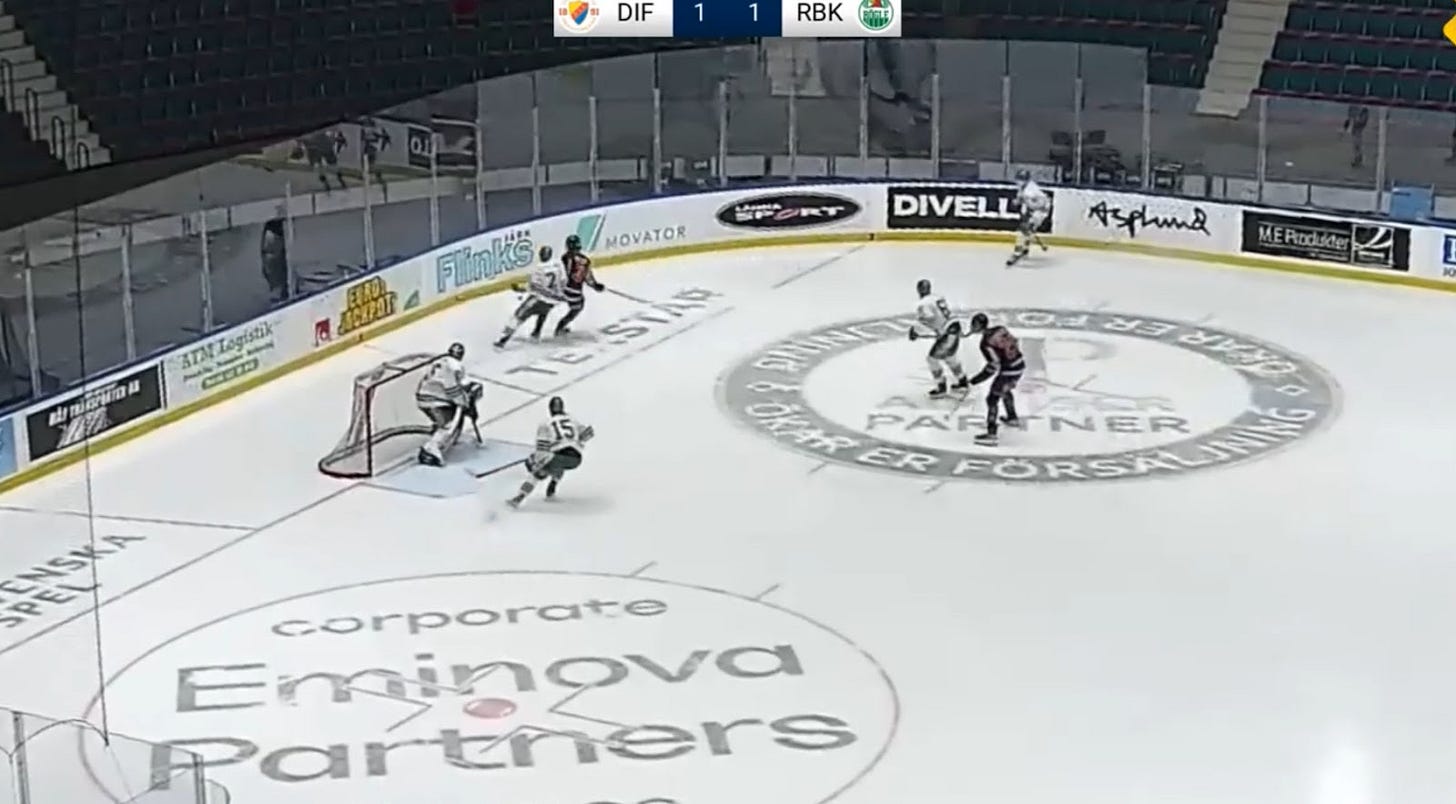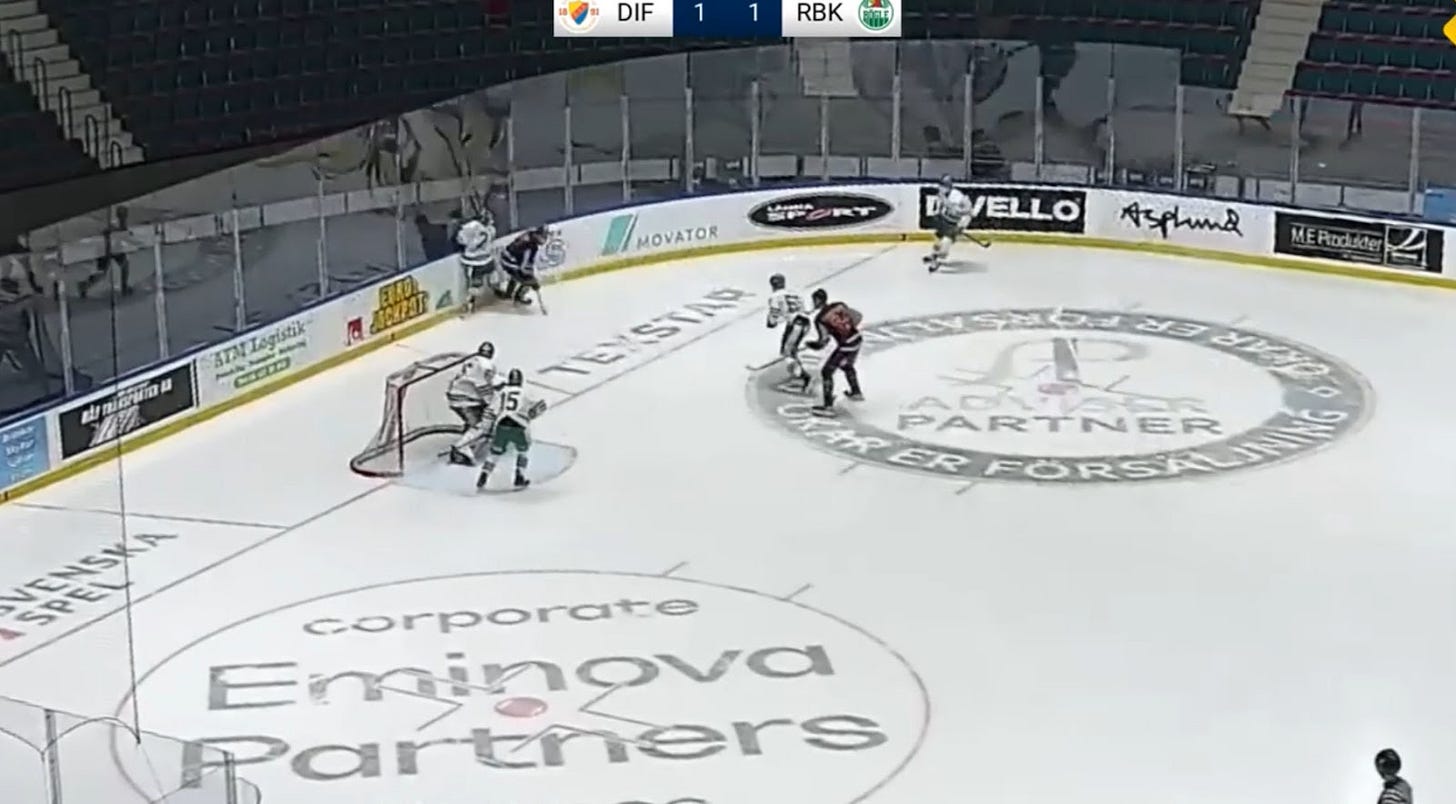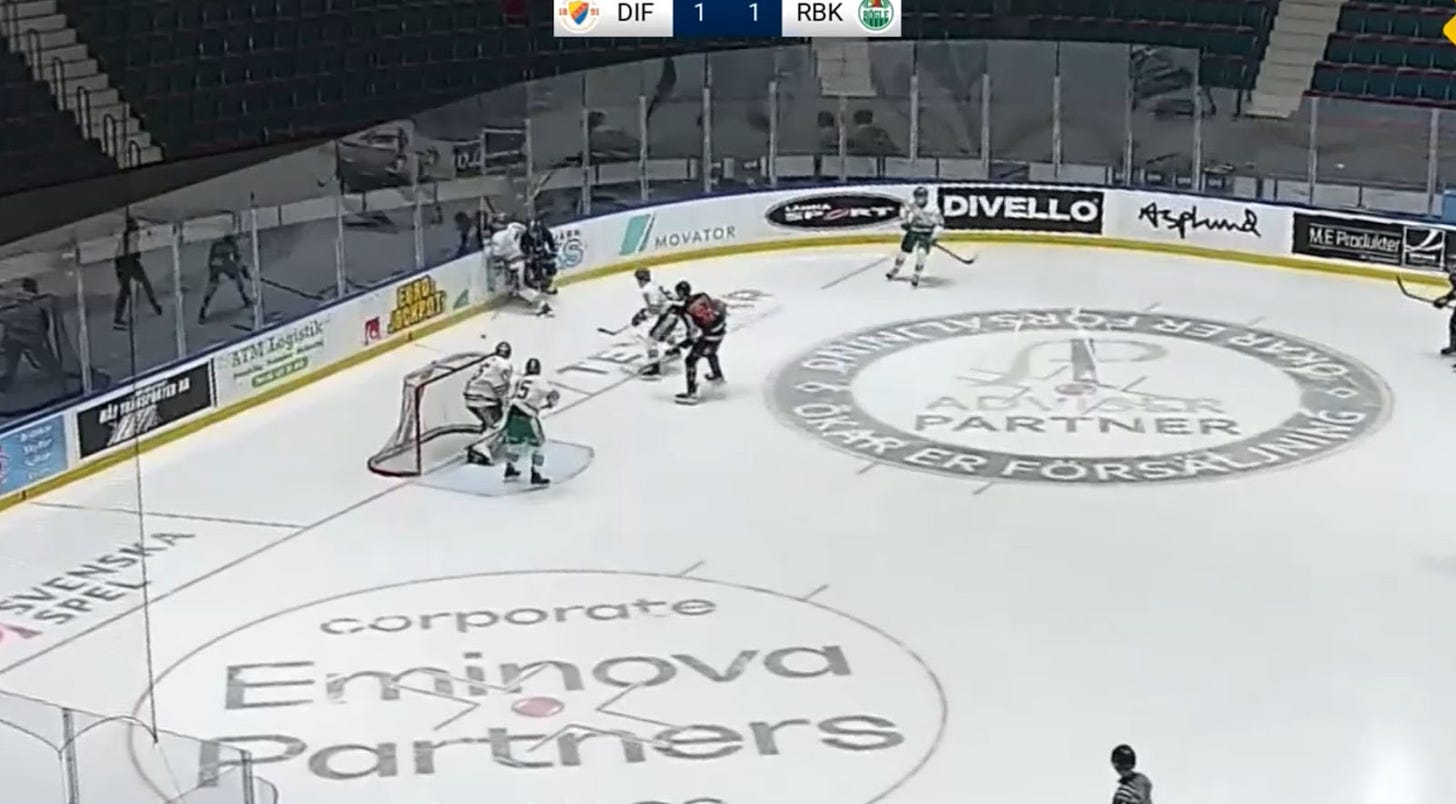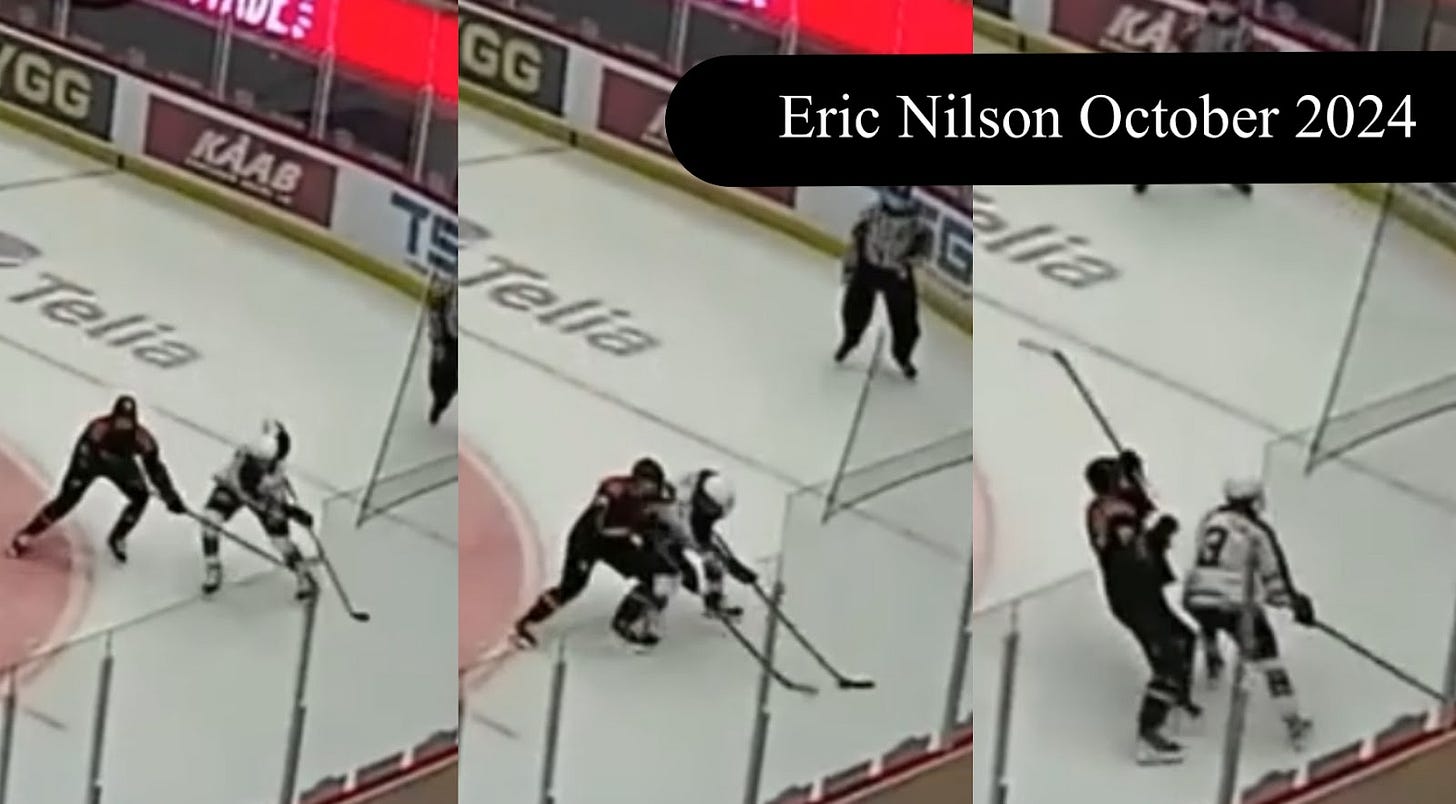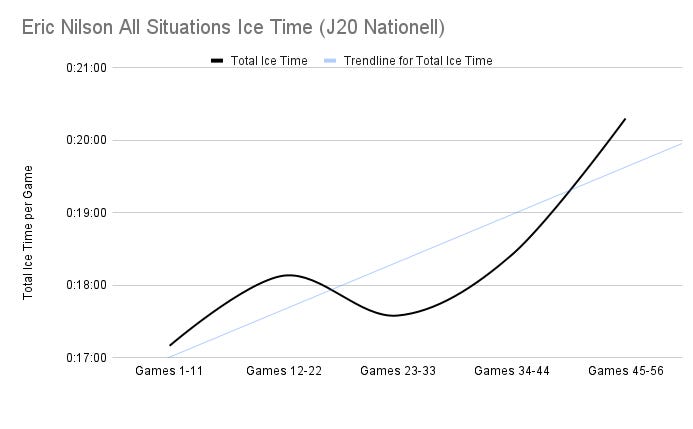Skating:
- Straight Line Skating:
As a straight line skater, Eric Nilson is fine. He lacks game-breaking speed but has enough quickness to succeed at the level he plays at and could develop with refined mechanics. He’s not very explosive, he lacks quickness in his acceleration phase and because of this he doesn't win many foot races for loose pucks and likely won’t be able to separate with only skating. His top end speed is serviceable once he gets going however, which is a testament to his athleticism. Looking at his mechanics, he is too upright in his posture and this is one of the first things I would work on. His front knee bend is inconsistent but he has improved in this aspect as the season has gone on. There could be ankle flexion issues which could help explain why it is difficult for him to accelerate quickly or transition efficiently through directional changes. At times, his stride recovery swings too far in front of him, instead of returning under his body, because of this he loses power, balance, and speed because he can’t push off efficiently. I am nitpicking though, he is a fine skater who plays with pace and with refined mechanics he could be even better.
Nilson had a top tracked speed in the 49th percentile of all players I have tracked in my 4 year dataset in the 3 J20/Allsvenskan games I tracked of him this season. I should mention that my dataset may be a skewed sample due to my tendency to want to track faster players. Watching Nilson, if he can improve his upright posture, his top end speed can greatly improve thanks to his athleticism, even without fixing other parts of his stride.
Lateral Skating:
Nilson is quite impressive moving laterally. He has shown to leverage both linear crossovers and crossover acceleration to build and change speed very effectively at points this season. He utilizes crossovers to shift laterally, helping him control his speed creation and evade forecheckers and navigate congested areas of the ice. His ability to change speeds quickly creates space for himself and is one of his main forms of space creation. His greatest strength lies in his edgework and balance, allowing him to maintain control during tight turns and quick changes of direction. His ability to pivot sharply, makes him difficult to knock off stride even in high-pressure situations. This also aids his puck protection, as he can shield the puck effectively while maneuvering along the boards or through traffic.
However, Nilson’s lateral movement has notable weaknesses. He lacks explosive side-to-side bursts, limiting his ability to create sudden separation from defenders, which hurts his rush offence. His wide stride recoveries reduce his overall efficiency, sometimes causing slight delays in his directional changes. Furthermore, his movements can appear stiff at times, restricting the deceptive elements of his skating that could otherwise help him manipulate defenders more effectively. Overall, Nilson’s lateral skating is functional and reliable rather than dynamic. He excels in maintaining possession and navigating tight spaces but does not possess the elite agility needed to consistently break games open with his east-west mobility. His skating is sufficient, but further refinement in his mechanics could elevate his effectiveness.
Skills:
Two-Way Game
Eric Nilson has established himself as one of the most defensively effective forwards in the 2025 draft class. His game is built on consistent pressure, anticipation, and high energy play that disrupts opponents and limits high quality chances against. While he may not stand out for offensive production, his defensive impact is measurable and significant. Nilson disrupts plays at a high rate. Among J20 Nationell forwards, he ranks in the 98th percentile in EV takeaways per 60 (minimum 15 games per Instat), demonstrating his ability to read the game and break up possession. He does not simply defend passively, he pressures opponents early, forcing mistakes before plays develop. He thrives on anticipation. He reads developing plays early, recognizing passing lanes before they materialize. His active stick is a constant nuisance, giving him an advantage in board battles and intercepting high danger passes. What really separates Nilson is his consistency in applying pressure. He hunts puck carriers with controlled aggression, angling attackers toward the boards to negate scoring threats. His effectiveness on the forecheck and penalty kill, add to his ability to limit chances against. His tendency to hound opponents and take away space is very noticeable when you watch him. His defensive play is active rather than reactive, creating turnovers that often lead to transition opportunities.
His defensive results are more impressive given his usage. Nilson frequently matched up against opposing top lines, both with the J20 team and at the international level, yet he allowed the third-lowest expected goals against per 60 among Djurgården U20 team. This indicates his ability to suppress scoring chances even against strong competition. Nilson recognizes dangerous situations and jump into action without hesitation, whether it’s hustling back into his own zone to cover open space, angling opposing puck carriers to the boards, or picking up late-attacking forwards to snuff out scoring threats. Even when facing experienced men in Allsvenskan, Nilson stays competitive, winning puck races, fending off pressure, and leaning into battles in tight areas. What’s especially valuable is his constant awareness: knowing when to step into lanes, how to position himself between the puck and the net, and utilizing his skating ability to close down plays quickly. Even when he doesn’t come away with the puck directly, his willingness to chase back hard, finish checks, and stick with the play prevents opponents from sustaining offensive zone time. He breaks up plays in multiple ways, through stick lifts in board battles, interceptions in passing lanes, and consistent pressure that forces rushed decisions from opponents. Nilson’s two-way impact extends beyond defense. Some of his best plays often come after turnovers, where he quickly transitions into offence.
Adding strength would help him handle bigger opponents and it's something he needs to do. However, his defensive game is already both advanced and translatable for his age. In a league where skilled players often thrive on bigger ice, Nilson stands out as a player who can influence games through steady, effective, high energy two-way play.
Playmaking
Nilson’s game is built around clever, well-timed passes and his ability to read the ice at a high level. Throughout the season, he’s been one of the most reliable passers in the Swedish junior circuit, consistently spotting lanes and delivering passes that generate scoring chances. Whether supporting his teammates down low, covering and flowing through important areas, or stepping up into the rush, Nilson threads plays together with poise and awareness, often functioning as a the player who dictates play and sets the tempo. While his skill, puck support, and creativity highlight his high-end playmaking potential that will only grow with further strength and development. At even strength, Nilson ranks in the 68th percentile for shot assists per 60 and 75th percentile for high-danger passes per 60 among J20 Nationell forwards. These numbers reflect his ability to consistently put teammates in positions to score without forcing plays. His 96th percentile ranking in completed passes per 60 at even strength, coupled with a 71st percentile pass completion percentage, demonstrates both his volume and efficiency as a puck distributor.
The Swedish forward's playmaking takes a noticeable leap on the power play, where he jumps to the 93rd percentile in shot assists and maintains a 70th percentile ranking in high-danger passes per 60. This special teams boost suggests an understanding of how to exploit structured defenses, his ability to manipulate defensive sticks to open passing lanes and make quick reads to high danger areas raises his playmaking ceiling. Nilson's passing game thrives on timing and deception rather than pure skill, but he does have quite a bit of skill. He shows patience in possession, circling the zone looking for a play and he uses his body language to freeze defenders before making his next play. He can recognize when his teammates are open in valuable spots, at many points this season he;s been able to find his teammate with a cross-slot feed, but he understands offensive layering well enough to create off the rush using the same subtle body language fakes and playmaking vision.
The consistency of his playmaking stands out. Even in games where he wasn't dominant offensively, he made some nice connecting small-area plays that moved the puck along the boards and managed to execute multiple small-area entry passes on the first touch. This reliability stems from strong fundamentals, he scans before getting every puck and prefers to make fast processed plays rather than attempting highlight-reel passes. He can sometimes hold onto the puck when he shouldn’t. As Nilson continues to develop, he will continue to refine his ability to manipulate coverage and make plays through noise. He already shows the makings of an effective distributor who can facilitate offense within a high level system.
Motor:
Nilson’s forechecking and overall motor stand out as one of his most defining traits, bringing intensity and purpose to every shift. Throughout the season, you see him hunting pucks with a fearless, never-quit attitude, regularly getting in on the forecheck to disrupt breakouts and force turnovers. Even against older, stronger opponents at the men’s level, Nilson closes gaps with impressive intensity, applies his body along the boards, and stays engaged until he wrestles back possession or at least slows the play. He doesn’t wait for the game to come to him, he jumps into action as the first forechecker, pinning defensemen deep and creating havoc below the goal line. What’s especially notable is his stamina and compete level; Nilson can do this on repeat, shifting seamlessly between offensive-zone pressure and defensive recovery. This relentless motor and forechecking presence make him a constant thorn for opposing teams and help him control the pace of play, buying his team extra time and offensive-zone possessions all game long. This work rate makes him a disruptive presence even when not producing offensively. Competitiveness is a real skill because if everyone could play with his motor/competitiveness everyone would.
Nilson engages in puck battles at an elite rate, ranking in the 94th percentile among J20 Nationell forwards in puck battles per 60 minutes. While his current 73rd percentile battle win rate reflects physical limitations, the frequency with which he initiates contact speaks to his aggressive mindset. Watching him it's clear how much energy he brings in all situations, this is most noticeable on the backcheck and his ability to hound carriers is commendable. This persistent pressure forces rushed plays from opponents, even when he doesn't directly gain possession. His forechecking stands out as a particular strength. He has a knack for appearing to disrupt the opponent at the right time, showing strong anticipation skills to complement his work ethic. When he does force turnovers, he quickly transitions to offense, as seen in sequences where he won puck battles along the boards before immediately creating scoring chances. Defensively, I;ve already mentioned how Nilson's motor allows him to cover substantial ice. He regularly provides strong puck support, constantly giving defensemen good options on breakouts while remaining ready to backtrack. His penalty killing effectiveness stems from this combination of awareness and effort, he sacrificed his body for multiple blocks even when leading by six goals. This commitment to defensive details, sticking to checks, filling passing lanes, and providing back pressure, makes him reliable in shutdown situations.
The main constraint on Nilson's effectiveness remains physical development. While he engages in battles frequently, his current frame limits his ability to consistently win them against stronger opponents. Adding muscle would help convert more of his 94th percentile battle frequency into possession gains. There are also occasional lapses in positioning when his aggressive approach causes over-pursuit. His willingness to chip pucks into space and forecheck aggressively turns would-be defensive zone exits into sustained offensive pressure. Even when not registering points, he creates value by driving play up ice through sheer persistence. This two-way motor projects as Nilson's most NHL translatable skill. While he may never develop into a primary scorer, his ability to play at a high pace all game and annoy opponents into mistakes provides a clear role at higher levels. The next steps involve refining his positioning to maximize efficiency and adding strength to convert more of his engagements into possession. If he can maintain this compete level while improving his battle success rate.
Puck Protection
One of Nilson’s most notable puck protection traits is his composure when pressured. Unlike many young players who rush plays under duress, Nilson demonstrates an advanced ability to delay, fake, and manipulate defenders to create separation. His patience is great, he can pause situations to make the right play rather than forcing low-percentage passes. A prime example comes from a game where he retrieved the puck in his own zone under heavy backchecking pressure. Instead of panicking, he executed a series of feints and curl-backs, disrupting the forechecker’s momentum before accelerating up ice. This ability to slow the game down in high-pressure scenarios is rare for players his age and suggests strong spatial awareness. Instat data supports this, showing that despite ranking in the 96th percentile in EV puck touches per 60, he averages only 69th percentile time per touch.
Nilson’s puck protection is further enhanced by his body positioning and stickhandling. He excels at using his edges to shield the puck, often employing open-hip turns, quick cutbacks, and sudden changes of direction to evade stick checks. His ability to blend weight-shift hands with tricky edge work, allows him to escape pressure along the walls. His low center of gravity aids in maintaining balance when engaged physically, though his lack of elite strength means he relies more on agility than brute force. In one sequence, he received a rimmed puck along the boards, used a skate fake to wrong-foot the defender, and then accelerated into open ice. This kind of deception is crucial for NHL translatability, as it allows him to extend possession even against bigger, stronger opponents. One recurring observation is his ability to seal pucks along the wall before making a short-area pass to a teammate. In a playoff game, he was seen using a spin-off move to protect the puck from a defender, buying time for support to arrive. These small but valuable plays help sustain offensive zone time, a trait that will serve him well in a checking-line role. Nilson’s ability to carry the puck through the neutral zone under pressure is another strength. He frequently employs crossovers and lateral cuts to navigate tight spaces, and his habit of scanning while carrying to identify passing lanes is a crucial skill that speaks to his aforementioned long-term playmaking potential. His lack of elite top speed means the puck protection skills he has are even more important as he won’t burn defenders wide. His change-of-pace agility helps him to slip past opponents too. While he sometimes defaults to safer plays rather than attacking aggressively, his ability to maintain possession in transition reduces turnovers, a valuable trait for any forward.
His lack of strength occasionally leads to him being outmuscled, particularly against bigger defensemen. Adding muscle will be crucial for him to sustain possession in the NHL, where board play is more physically demanding. Additionally, while his patience is an asset, he could benefit from more deception in his movement patterns. At times, he telegraphs these with his head and eye movement, allowing defenders to close gaps and passing lanes. Incorporating more fake shots, look-offs, and delayed releases would make him even harder to defend.
Perception:
Tactical Recognitions
Eric Nilson's development during Djurgårdens IF J20's championship-winning season (33-8-7) was significantly shaped by the team's dominance. Djurgården's team-wide dominance provided a foundation for Nilson's growth. The squad led the J20 Nationell in key offensive metrics, including expected goals (61% xGF%), possession (62% Corsi), offensive zone cycles, and time on attack. This high-possession system allowed Nilson to thrive in puck support situations and cycle play, masking some of his transitional limitations. His deployment as the second-most-used forward (18:19 TOI/GP), combined with first-unit power play (2:25) and penalty kill (1:26) minutes, demonstrated the coaching staff's trust in his versatility. Playing primarily with skilled linemates like Arvid Drott and Melvin Wersäll in this environment gave him opportunities to contribute without shouldering primary offensive responsibilities
Nilson benefited from Djurgården's approach of sheltering his offensive deployment while emphasizing defensive growth. He also had limited HockeyAllsvenskan exposure (4 GP @ 6:25 TOI per game), and supplemental J18 appearances, suggests a strategy to balance competition level with his physical maturation
However, Djurgården's J20 advantages also could create questions about Nilson's production. The team's puck possession and scoring chance generation inflated metrics for all players, while his reliance on skilled linemates reduced his need to drive play independently. However, such environments can be particularly beneficial for late-maturing prospects, allowing them to refine skills against appropriate competition before physical maturity is complete. Yet Nilson's next transition will test whether his two-way game can adapt against stronger, more physically developed opponents. Moving into next year, Nilson has committed to the Michigan State Spartans. It will be interesting to see how he adapts as the Spartans play a fast, physical, more direct style of play that focuses on creating counter attack chances, in which they lead the big 10 on a per game basis. The skill level of their players allows them to play at faster pace and carry a lot of their speed through the neutral zone, Nilson has the offensive layering puck and processing skills to succeed in a fast pace system like this but needs to improve his skating and strength to take full advantage.
Speed Perception
The foundation of Nilson's game is his speed perception, his capacity to read plays before they develop and make quick, effective decisions with or without the puck. This manifests in several key areas that translate directly to modern NHL play. In transition, he demonstrates an advanced understanding of when to carry, when to pass, and when to delay to create better options. Defensively, he anticipates opponents' movements, regularly disrupting plays before they become dangerous. His scanning habits allow him to make plays under pressure that many junior players cannot, as he consistently identifies passing lanes and open ice before receiving the puck.
Eric Nilson presents as one of the most translatable center prospects in the 2025 NHL Draft class. His game combines strong hockey sense with reliable two-way play, making him a viable candidate for teams seeking a safe but valuable middle-six projection. The Michigan State commit will have a solid development environment to refine his skills before turning professional. Nilson's most projectable NHL qualities stem from his defensive reliability and potential. He reads plays effectively in all three zones, demonstrating consistent awareness without the puck. Cognitive strengths like these give him a clear pathway to NHL minutes, even if his offensive upside doesn't develop beyond secondary scoring.
Physically, he needs to add strength to better handle puck battles and net-front situations. His skating, while solid for the level he plays, lacks explosive power that would help him create separation at the next level. Offensively, he could benefit from taking more calculated risks rather than defaulting to safe plays. His shot mechanics and shot selection could also use refinement to take better opportunities in scoring areas. Nilson's realistic projection falls somewhere between a defensive third-line center and a two-way middle-six forward. His floor appears to be that of a penalty-killing specialist who can provide depth scoring. With proper development, he could grow into a more complete player capable of handling matchup minutes and provide supplemental scoring.
While he may never be the most exciting or flashiest prospect in the class, Nilson has all the makings of a player who will be valued by coaches and teammates for his ability to play hard in all situations. In my view he is a legitimate top-15 talent, he doesn’t have flashy offensive production or physical dominance compared to his peers in this range but his combination of hockey intelligence, two-way reliability and skating creates a prospect profile that offers substantive defensive upside.
Finlay Sherratt
June 2024
613-879-4316





